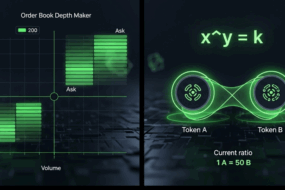
Crypto derivatives trading has opened new opportunities for traders, allowing them to control large positions with relatively small amounts of capital. While concepts like leverage and margin often get the most attention, one of the most important yet overlooked ideas is notional value. Understanding notional value is not just about learning a technical term. It is about gaining a deeper perspective on how much exposure you actually hold in the market, how liquidation prices are calculated, and how profit or loss is magnified through leverage.
In this guide, we will break down what notional value means in crypto, how to calculate it, why it matters for risk management, and how traders can use it strategically.
Quick Notional-Value Cheat Sheet
| Pair | Contract Size | Price | Notional | Leverage 10x Margin |
| BTC/USDT | 0.05 BTC | $60,000 | $3,000 | $300 |
| DOT/USDT | 1,000 DOT | $6 | $6,000 | $600 |
This table shows how a small margin deposit can control a much larger position. With only $300 in margin at 10x leverage, a trader has exposure to $3,000 worth of Bitcoin. Similarly, $600 can control $6,000 worth of DOT.
What is Notional Value in Crypto?
Notional value, sometimes called nominal value or face value, represents the total value of a leveraged trading position. It is calculated by multiplying the contract size by the current price of the underlying cryptocurrency.
For example, if you hold a contract of 1,000 DOT and the current price of DOT is $6, the notional value is $6,000. If the price rises to $9, the notional value instantly increases to $9,000, even though your margin remains unchanged.
This metric is essential because it reflects your actual exposure in the market, not just the amount of margin you deposited.
Why Notional Value Matters in Perpetual Trading
- Leverage calculation: Notional value determines how leverage impacts your position. A trader using 10x leverage with $600 in margin will have $6,000 of notional exposure.
- Risk management: Liquidation thresholds are derived from notional value. The larger the notional relative to your collateral, the closer liquidation sits to your entry price.
- Profit and loss (P&L): P&L in derivatives trading is tied directly to notional exposure. Even small price swings in the underlying asset can translate into large changes in account balance.
Without understanding notional value, traders may underestimate how quickly their positions can move into profit or loss.
How to Calculate Notional Value
The calculation is simple but powerful:
Notional Value = Contract Size × Current Trading Price
Example 1:
A BTC perpetual contract size is 0.05 BTC. If the Bitcoin price is $60,000, the notional value is $3,000.
Example 2:
A DOT perpetual contract size is 1,000 DOT. If the price is $6, the notional value is $6,000.
This calculation gives you the theoretical market exposure your trade carries.
What Affects the Notional Value of a Contract?
- Contract Size (Position Size): Adding leverage or increasing lot size boosts the notional value.
- $100 margin at 10x leverage controls $1,000 worth of crypto.
- $100 margin at 20x leverage controls $2,000 worth of crypto.
- Price of the Asset: Notional value rises and falls as the underlying crypto price changes.
- 1,000 DOT at $6 = $6,000 notional.
- 1,000 DOT at $9 = $9,000 notional.
- Margin Mode:
- In cross-margin mode, all available balance is used to maintain positions.
- In isolated margin mode, each position has its own margin, keeping notional exposure and risk separated.
Notional Value vs. Market Value
It is important to distinguish between notional and market value. Market value refers to the real money you put up as margin. Notional value, on the other hand, reflects the full exposure of your trade.
Example: With $1,000 margin at 10x leverage, the market value is $1,000 but the notional value is $10,000. This gap is what creates both the opportunity and the risk in leveraged trading.
Using Notional Value in Risk Management
- Position sizing: Traders can use notional value to determine how much exposure they want relative to their portfolio size.
- Hedging strategies: Professional traders often use notional value when calculating hedge ratios between futures and spot markets.
- Capital efficiency: Monitoring notional value helps prevent over-leveraging, which can quickly lead to liquidation in volatile markets.
Conclusion
Notional value is more than just a technical definition. It is the backbone of leveraged trading in crypto markets. By calculating and understanding notional value, traders gain clarity on their true exposure, improve their risk management, and create more disciplined strategies.
While it may seem like a small detail, ignoring notional value can result in sudden losses and poorly managed trades. On the other hand, using it effectively can help traders make smarter entries and exits, plan hedges, and manage liquidation risks more confidently.
Mastering notional value is not optional if you want to succeed in crypto derivatives. It is the key metric that ties together leverage, risk, and profitability.
FAQ: Notional Value in Crypto
1. What is the difference between notional value and market value?
Notional value is the theoretical exposure of your contract. Market value, or margin, is the actual cash you commit to open the trade.
2. How do I calculate notional value on a crypto perpetual contract?
Multiply contract size by the coin’s current price. Example: 1,000 DOT × $6 = $6,000 notional.
3. Why does leverage matter more than margin in notional sizing?
Leverage expands contract size without requiring more capital. Every 1x increase in leverage multiplies notional exposure, and with it, your potential gains and losses.
4. How does notional value influence liquidation price?
Exchanges calculate liquidation thresholds based on notional value. The higher the notional relative to your margin, the closer liquidation is to your entry.
5. Can my notional exposure change after I open a trade?
Yes. Even without changing leverage, the notional value changes as the asset price fluctuates. This means your risk is dynamic in real time.
6. Is notional value important for spot traders?
Not directly. Spot purchases are always 1:1 with cash. Notional becomes important only when using derivatives or leveraged products.
7. Are there exchange-imposed limits on notional value?
Yes. Most platforms cap notional exposure per account or per contract. On Bitunix, for instance, tiered margin rates are tied to specific notional brackets to control systemic risk.
About Bitunix
Bitunix is one of the world’s fastest growing professional derivatives exchanges, trusted by over 3 million users across more than one hundred countries. Ranked among the top exchanges on major data aggregators, Bitunix processes billions in daily volume and offers a comprehensive suite of products including perpetual futures with high leverage, spot markets, and copy trading. Users can trade bitcoin and other major cryptocurrencies on the platform, taking advantage of advanced trading features. Known for its Ultra K line trading experience and responsive support, Bitunix provides a secure, transparent, and rewarding environment for both professional and everyday traders. Bitunix Academy adds structured lessons so you can build skills while you trade.
Bitunix Global Accounts
X | Telegram Announcements | Telegram Global | CoinMarketCap | Instagram | Facebook | LinkedIn | Reddit | Medium
Disclaimer: Trading digital assets involves risk and may result in the loss of capital. Always do your own research. Terms, conditions, and regional restrictions may apply.












